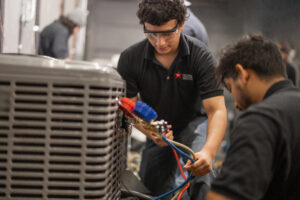Step 1: Eligibility Check
Before diving into commercial driving, confirming that you meet the initial requirements for obtaining a CDL-A in Texas is essential. This is your foundation, your eligibility checkpoint. Let’s break it down:
First and foremost, you must be at least 18 years old to drive within the state. However, if your ambitions extend beyond Texas, you must be at least 21 to traverse state lines. Age is not just a number; it signifies the maturity and experience necessary for safely operating large commercial vehicles.
Another prerequisite is holding a valid Texas driver’s license. After all, the CDL-A is a specialized license that builds upon your existing driving credentials. It’s the key to the kingdom of commercial driving.
However, the eligibility journey continues. Meeting specific medical requirements is crucial. Don’t worry; we’ll delve deeper into this aspect shortly. But remember, your journey begins with these fundamental eligibility criteria.
Step 2: CDL Class and Endorsements Selection
Now that we’ve confirmed your eligibility, it’s time to explore the world of CDL classes and endorsements. These choices determine the trajectory of your career as a commercial driver. Let’s examine your options:
Class A CDL: This is the golden ticket to operate any combination of vehicles with a gross combination weight rating (GCWR) exceeding 26,001 pounds. In simpler terms, you can command many vehicles, provided the towed vehicles have a gross weight rating (GVWR) of over 10,000 pounds. This is your class if you envision yourself behind the wheel of tractor-trailers.
Class B CDL: On the other hand, if your career aspirations lean towards operating a single vehicle with a GVWR of 26,001 pounds or more or perhaps towing another vehicle not exceeding 10,000 pounds, the Class B CDL is your choice. Those interested in delivery trucks, school buses, and smaller commercial vehicles often prefer this class.
Class C CDL: The Class C CDL is suitable for operating single vehicles with a GVWR of less than 26,001 pounds or towing another vehicle not exceeding 10,000 pounds. However, this should not involve a Class A or B vehicle combination. This class often leads to careers in passenger transport or lighter cargo hauling.
In addition to selecting the appropriate CDL class, you may need endorsements based on the type of cargo you plan to transport or the vehicles you intend to operate. These endorsements include:
- Tanker (N): This endorsement allows you to transport liquids or gases in tank vehicles, making it essential if you plan to haul fuel or chemicals.
- Double/Triple Trailer (T): If you have dreams of maneuvering a vehicle with two or three trailers, this endorsement is a must. It’s the gateway to long-haul trucking or specialty transport.
- Passenger (P): You can legally transport passengers with a passenger endorsement. This is a prerequisite for becoming a bus driver, whether for a school or public transit system.
- Hazardous Materials (H): When it comes to transporting hazardous materials, safety is paramount. The hazardous materials endorsement equips you to handle dangerous cargo responsibly.
- School Bus (S): If you aspire to operate a school bus and become a trusted driver for students, the school bus endorsement is a necessity.
- Combination (X): For those who wish to handle a variety of hazardous materials and tank vehicles, the combination endorsement is invaluable. It opens doors to specialized transport opportunities.
One important note: Since February 7, 2022, the Federal Motor Carrier Safety Administration (FMCSA) has mandated compliance with the new Entry-Level Driver Training (ELDT) regulations. To meet these requirements, you must undergo theory training from an approved provider listed in the FMCSA Training Provider Registry (TPR) if you plan to take the written test for a Class A or Class B CDL, upgrade an existing CDL, or receive an initial school bus, passenger, or hazardous material endorsement. Additionally, behind-the-wheel (BTW) training from an approved BTW training provider listed in the TPR is essential for the road skills test.
Now, let’s discuss the pivotal step of preparing for your CDL-A journey: enrolling in the Southern Careers Institute (SCI).
Step 3: Enroll with Southern Careers Institute (SCI)
Southern Careers Institute (SCI) is your trusted partner in realizing your CDL-A dreams. With SCI, you gain access to a wealth of resources and support that will set you on the path to success in the trucking industry. Here’s why enrolling with SCI is a game-changer:
- Experienced Instructors: SCI boasts a team of professional instructors who are educators and mentors committed to your success. They will guide you through every aspect of CDL-A training, from theory to hands-on skills. With their industry insights and hands-on experience, you’ll receive top-notch instruction.
- Modern Facilities: At SCI, you’ll train in facilities with cutting-edge equipment and technology. Our training equipment ensures you’re prepared to operate the latest commercial vehicles safely and effectively.
- Comprehensive Curriculum: The SCI CDL-A program covers all the essentials, leaving no stone unturned in your preparation for the written and skills tests. You’ll gain a deep understanding of the principles of safe and responsible commercial driving.
- Flexible Schedules: SCI understands that life can be hectic, and balancing CDL-A training with existing commitments can be challenging. That’s why they offer flexible training schedules, allowing you to choose the best time.
- Career Support: Beyond training, SCI provides invaluable job placement assistance. Their extensive network of industry connections can help you kickstart your career as a professional truck driver. From job listings to interview preparation, SCI has your back.
Selecting SCI as your training provider is critical to your CDL-A journey. Their unwavering commitment to your success makes them the ideal choice for aspiring truck drivers in Texas.
Step 4: Obtaining a Commercial Learner’s Permit (CLP)
Before beginning your CDL-A skills test journey, you must obtain a Commercial Learner’s Permit (CLP). This permit is your ticket to honing your skills and demonstrating your readiness for the road. Here’s how you can secure your CLP:
- Visit the Texas Department of Public Safety (DPS) office, where you’ll initiate the process.
- Present your valid Texas driver’s license and any other necessary documents. These documents may include proof of identity (e.g., birth certificate, passport), your Social Security card, proof of Texas residency (e.g., utility bill, bank statement), and the all-important Medical Examiner’s Certificate, which we’ll discuss in detail shortly.
- Pass a vision test to ensure your eyesight meets the necessary standards for safe driving.
- Ace the general knowledge test related to your chosen CDL class. This test evaluates your understanding of the rules of the road and the specific regulations that apply to commercial driving. It’s an essential step in ensuring you’re well-prepared for the responsibilities of a CDL-A.
Your CLP represents a crucial stage in your journey, allowing you to practice and refine your skills before the final test.
Step 5: Practice and Preparation
With your CLP in hand, it’s time to hit the road! The practice and preparation phase is a vital part of your journey to becoming a professional truck driver. Here’s how it works:
- You must practice driving a commercial vehicle for at least 14 days. During this period, you’ll gain valuable hands-on experience, becoming familiar with the nuances of operating a commercial vehicle safely and efficiently.
- To ensure that your practice sessions are productive and safe, you must be accompanied by a licensed driver who is at least 21 years old and holds the appropriate CDL class for your driving vehicle. This mentorship provides valuable guidance and ensures you learn from a seasoned professional.
This practice period is invaluable, as it allows you to build confidence in your abilities and become comfortable with the responsibilities of a commercial driver. It’s the bridge between classroom knowledge and real-world application.
Step 6: The CDL Skills Test
You’ve put in practice and gained valuable experience, and now it’s time to prove your skills. The CDL skills test is the culmination of your training journey, a comprehensive evaluation of your readiness to operate a commercial vehicle safely and responsibly. The test consists of three main components:
- Pre-Trip Inspection Test: This segment assesses your ability to thoroughly inspect your vehicle before hitting the road. You’ll be expected to identify and explain the various components and systems that must be checked for safety and functionality.
- Basic Controls Test: In this section, you’ll demonstrate your mastery of basic vehicle controls, including maneuvers such as straight-line backing, parallel parking, and alley docking. Your precision and control are under scrutiny here.
- Road Test: The road test is the grand finale, where you showcase your ability to navigate real-world driving scenarios safely. You’ll be evaluated on your ability to interact with traffic, obey traffic laws, and make sound decisions while driving a commercial vehicle.
Passing all three components of the CDL skills test is the key to obtaining your CDL-A. It’s the moment of truth, the culmination of your dedication and preparation.
Step 7: Obtaining Your Texas CDL
You’re just steps away from achieving your goal after successfully passing the CDL skills test and meeting all medical and other requirements. Here’s what you need to do:
- Visit the Texas Department of Public Safety (DPS) office to apply for your CDL-A. It’s the last stretch of your journey, and the finish line is in sight.
- You’ll need to provide several documents during this final phase, including your CLP, Medical Examiner’s Certificate, and any required endorsements (if applicable). Additionally, be prepared to cover any applicable fees as part of the process.
Once you’ve completed these steps and submitted all required documentation, the DPS will issue you a CDL-A. It’s a momentous occasion, realizing your dreams and beginning your career as a professional truck driver.
Medical Requirements
Meeting medical requirements is an integral part of obtaining CDL-A in Texas. This involves having a valid Medical Examiner’s Certificate, commonly known as a “DOT card.” Here’s how you can obtain this essential certificate:
- Find a Certified Medical Examiner: Your journey to a DOT card begins by locating a certified medical examiner. A list of certified medical examiners in Texas can be found on the FMCSA website. These professionals are trained and authorized to assess your medical fitness for commercial driving.
- Schedule an Appointment: Once you’ve identified a certified medical examiner, schedule an appointment for your medical examination. Be sure to bring any required documents, such as your driver’s license and Social Security card.
- Undergo a Physical Examination: You’ll undergo a thorough physical examination during your appointment. The medical examiner will assess various aspects of your health, including your vision, hearing, blood pressure, and overall physical condition. This examination ensures that you’re medically fit for the demands of a career on the road.
- Pay Any Required Fees: Be prepared to cover any fees associated with the medical examination. The cost is a small investment in your future as a commercial driver.
In addition to the medical examination, you must meet the federal physical qualification standards for drivers. These standards are in place to ensure that all commercial drivers are in good health and capable of safely operating large vehicles on the nation’s highways.
Conclusion: Your CDL-A Journey Starts with SCI
The road to earning your CDL-A in Texas may seem challenging. Still, it becomes an achievable and fulfilling endeavor with the right partner by your side. Southern Careers Institute (SCI) offers the guidance, training, and support you need to pursue a career as a professional truck driver confidently. Your journey begins with the decision to enroll with SCI. By choosing SCI as your training provider, you’re not just getting an education but a ticket to a future filled with exciting opportunities and endless horizons. SCI is more than an institution; it’s a launchpad for your career aspirations.
Don’t wait any longer—take the first step toward your CDL-A dreams by enrolling with SCI today. With SCI, you’re not just getting an education; you’re getting a ticket to a future where the open road beckons, adventure awaits, and success is measured by the miles you travel. Your CDL-A journey begins here, and the road ahead is full of promise and possibility. Choose SCI, and let your adventure begin!











